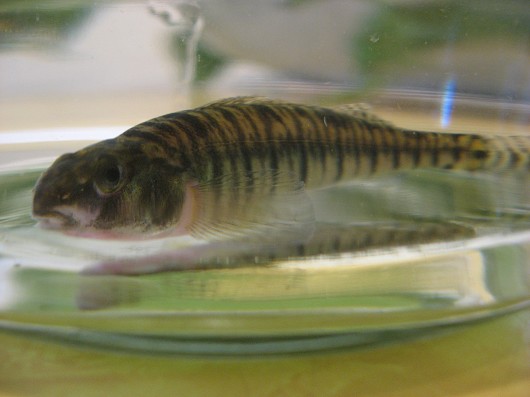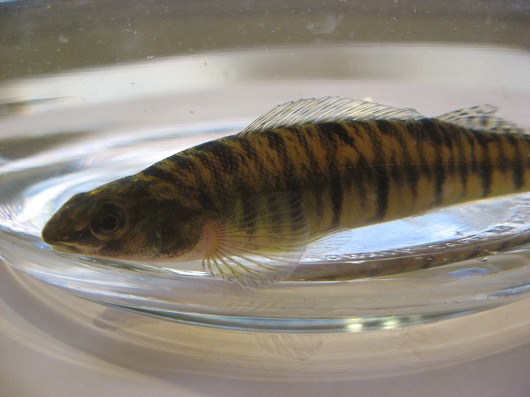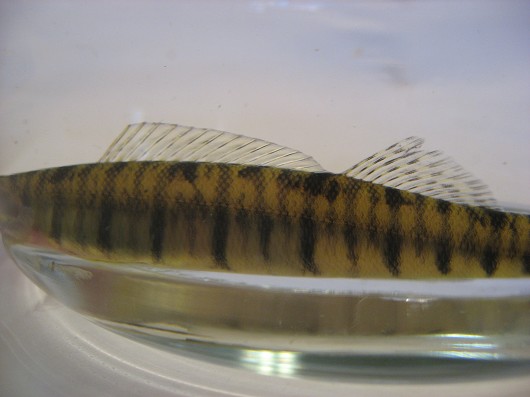Bigscale Logperch
-
Scientific NamePercina macrolepida
-
NativeNon-Native
-
Identification
 Bigscale logperch, captured from Putah Creek in November 2008. Photo by Teejay O'Rear, March 2009.
Bigscale logperch, captured from Putah Creek in November 2008. Photo by Teejay O'Rear, March 2009. Bigscale logperch, anterior. Captured from Putah Creek in November 2008. Photo by Teejay O'Rear, March 2009.
Bigscale logperch, anterior. Captured from Putah Creek in November 2008. Photo by Teejay O'Rear, March 2009. Bigscale logperch, dorsal fins. Captured from Putah Creek in November 2008. Photo by Teejay O'Rear, March 2009.
Bigscale logperch, dorsal fins. Captured from Putah Creek in November 2008. Photo by Teejay O'Rear, March 2009.- Long, slender, tubular bodies
- Pointed, projecting snouts
- Ctenoid scales cover breast, cheeks, operculars, and nape
- Row of large spiny scales on the belly
- 77-90 scales on lateral line
- Yellowish with 14-16 complete, dark, vertical stripes and a dark spot at the base of the tail
- Darker heads and orange bars on dorsal fins indicate a breeding male
- 2 small, well separated dorsal fins (13-15 spines, and 12-15 fin rays on the first and second fin respectively)
- Enlarged, fan-like pectoral fins with 12-14 fin rays
- 2 spines and 7-10 fin rays on anal fin
- 1 spine and 5 fin rays on the pelvic fins
-
Life History
Bigscale logperch can be found in a variety of habitats including the slow moving sections of warm, clear streams and the shallow areas of reservoirs with bottoms covered in mud, gravel, rock, and other debris. They have also been found in estuaries with salinities up to 4.2 ppt and the turbid waters of mud bottomed sloughs and ditches. In many of these areas they are often found at the edge of emergent vegetation. Here they bury themselves in the bottom and lay nearly motionless allowing their coloration to act as camouflage from predators. It also allows them to ambush any unsuspecting prey that may float by. More commonly, however, they will prowl close to the bottom, overturning debris with their snout and using their eyesight to catch a variety of invertebrates. Insect larvae are the most common prey but the bigscale logperch is a very opportunistic species and different populations will have very different diets depending on what is available. Schooling and territorial behavior is rare with the most social activity happening during the breeding season.
Maturity is reached in their second year and spawning occurs between February and mid-July. Mating consists of a unique ritual in which the female will stand on her tail to attract the male before the pair presses against each other in a vertical position. Once the ritual is complete the female lays 150-400 eggs onto the leaves of an aquatic plant or into a small gravel pit. Larvae are pelagic when hatched and will float downstream until they enter a side channel to rear. Young bigscale logperch will reach 48-81 mm in their first year and 75-102 mm in the second.
-
Links to Other ResearchN / A
-
WatershedN / A
Please note, watersheds are at the USGS 8-digit Hydrologic Unit Code (HUC) scale, so they often include a lot of sub-watersheds. If a species occurs in any sub-watershed within the HUC, the species appears within the HUC. Link to an EPA page that shows HUCs.


